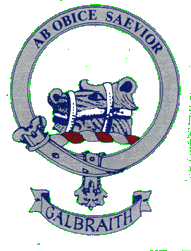
Home Page
Campbell and Lang Families
Intro to Argyll 'Roots"
Castle Sween
Clan Campbell
Clan MacEwan
Clan MacNeill
Kilvicocharmaig
Clan Galbraith: Children of the Britons
"Galbraith" derives from the Gaelic, meaning "Foreigner Breton"; and the family was known as "Clann-‘a-Bhreatannich" or ‘Children of the Britons'. The clan crest, a muzzled bear, may allude to the ancient British heroic name of ARTHUR, which means ‘bear', a name used in their family. "As Obice Suavior" means ‘sweeter for there having difficulties.'
An early Galbraith stronghold was on the island of Inchgalbraith in Loch Lomond. Thomas, the 12th Chief of the Clan Galbraith, took up arms with his ally Lennox, against the King of Scotland, James IV, but was defeated, captured, and hanged in 1489. From then on it was downhill, the final chief having disappeared by 1700. The people of the clan scattered, and many in the 17th century came to southern Kintyre as part of an influx of lowland farmers.
There was another group of Galbraiths that appeared on the Island of Gigha from Galloway, by the 15th century. It produced harpers for the MacNeills of Gigha.
Graeme Baird, in his article on the "Galbraith Poet Harpers of Gigha" mentions that the ruined church at Keills, North Knapdale, contains a late 15th century grave slabe dedicated to an unknown father and his son, Alan: "On it is carved a clarsach, or harp. As the MacNeills of Gigha were the predominant kindred in the locality at the time, it is possible that this grave slab commemorates members of the MacBhreatnaigh family."